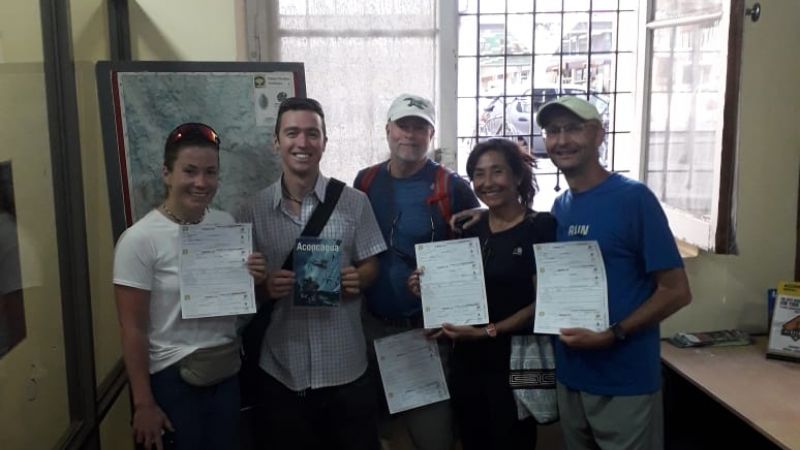HAPPY NEW YEAR, AND WELCOME ABOARD THE BLOG FOR OUR JANUARY ACONCAGUA TRIP!

Members Kristin, John, David and Dolores, with guide Nanik, have been prepping in the Mendoza summer for the last few days, checking and rechecking equipment and resting after travel from the USA, Norway and Singapore! But today, they have finally made their departure for the mountains and some fresh air! Pictured here with their permits, they have now left MDZ city, and will sleep today in Penitentes at an altitude of 3,500m. Tomorrow they move on to Las Cuevas, at a slightly more modest altitude of 3,200m, but we start hiking high and sleeping low in earnest, to start getting the lungs and muscles used to the thinner air at these altitudes.
This is the essential pre-acclimatization section of the three-week trip.
We’ll be taking the opportunity, as we follow their progress first at Las Cuevas and later in the Aconcagua Provincial Park, to introduce in detail this fascinating expedition.
Located in the Andes mountain range, Aconcagua is an iconic mountain located in the Mendoza Province of Argentina. As the highest mountain outside of Asia, Aconcagua’s summit elevation is 22,837 ft (6960.8 m). With this summit elevation, it has become widely known as the highest non-technical mountain in the world that still provides a tough endurance challenge.
- “Climbing Aconcagua should be on every mountaineer’s list. It’s tough, and a chance to learn about yourself while opening the door to many 8000+ meter summits around the world, especially in the Himalayas” – Nanik Stahringer, BBE Guide
While the normal route up Aconcagua is considered non-technical due to not absolutely requiring the use of ropes, ice axes, and pins, the mountain still poses its fair share of challenges. Altitude sickness and weather near the summit pose serious risks for climbers and can cause even the most experienced mountaineers to turn back, missing their summit attempt. Mountaineering is a dangerous sport and approaching even non-technical mountains pose great risks that should not be taken lightly.
With all of those factors in mind, Aconcagua can still be one of the best introductions to high altitude expedition climbing in the world. Even if you are an experienced rock climber, moving into high altitude expeditions requires a different set of skills and knowledge base. Having a team of expert guides like the Benegas Brothers can be the difference between a successful summit or not making it off the mountain at all.
Today’s Topic – When to Summit
The climbing season for Aconcagua is between November 15th and lasting until March 31st. While this climbing window is relatively large, there is still a peak season during this time: Mid-December through January. When you’re booking your climb on Aconcagua, keep these dates in mind and book early to ensure you have a spot. This is an extremely popular climb, especially if you plan to use the Normal Route.
- “I like January. The weather is often the best and the views are amazing” – Nanik Stahringer, BBE Guide
From the start of the season all the way until the very end, storms are a possibility. As with many high-altitude peaks, the weather can change quite drastically. Whiteouts near the summit are common and it is easy to get lost on the mountain. Having a guide with you will be helpful as they will have the proper training and summit knowledge to gauge safety in all weather conditions.
Snow, ice, and high winds are expected as you climb higher on the mountain. Summit temperatures remain quite cold year-round and frostbite is a possibility if not properly prepared for the conditions. It isn’t uncommon for temperatures to drop to -22 degrees Fahrenheit (-30 Celsius). High winds can make these temperatures seem much colder and make visibility difficult, even in lower regions due to dust.